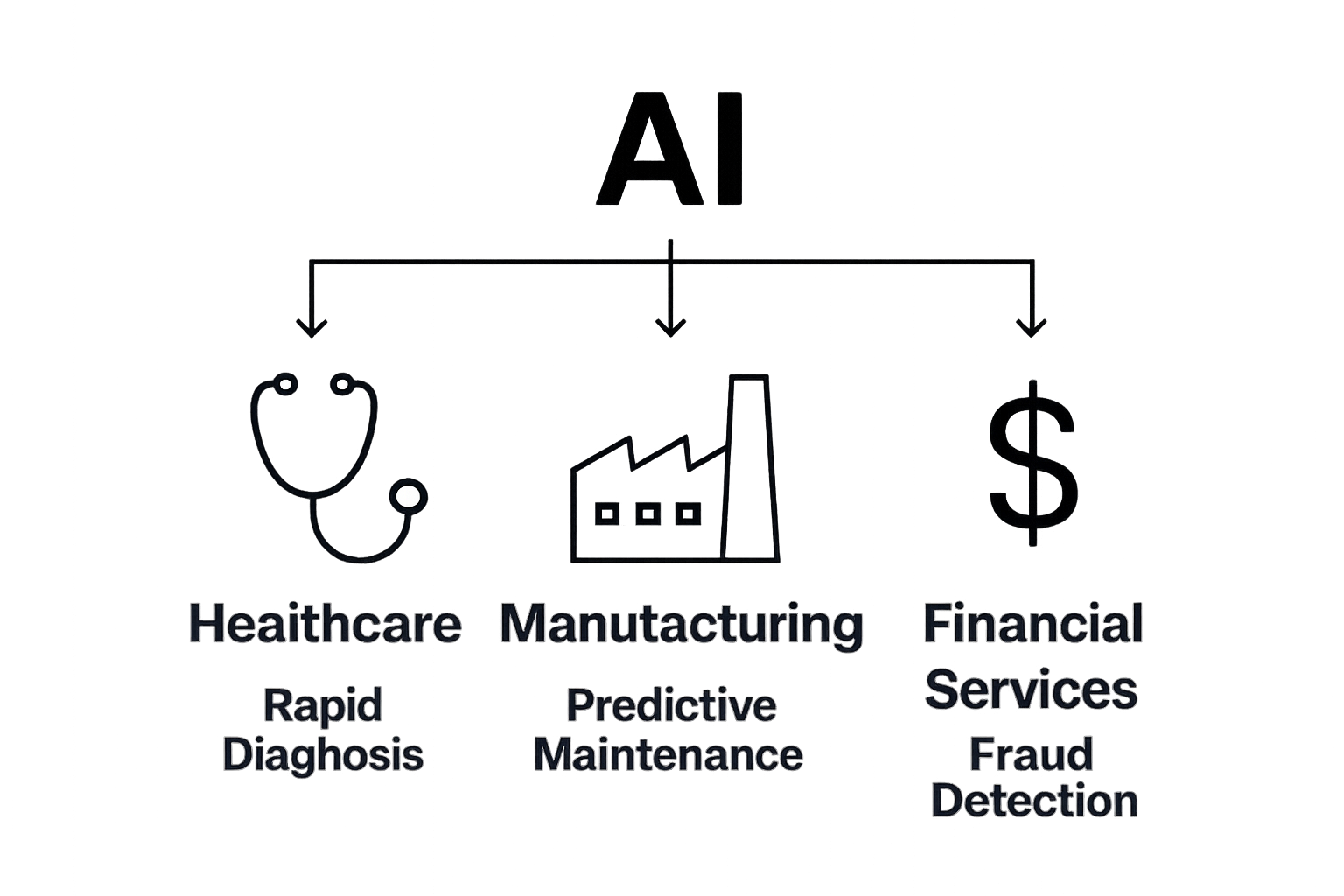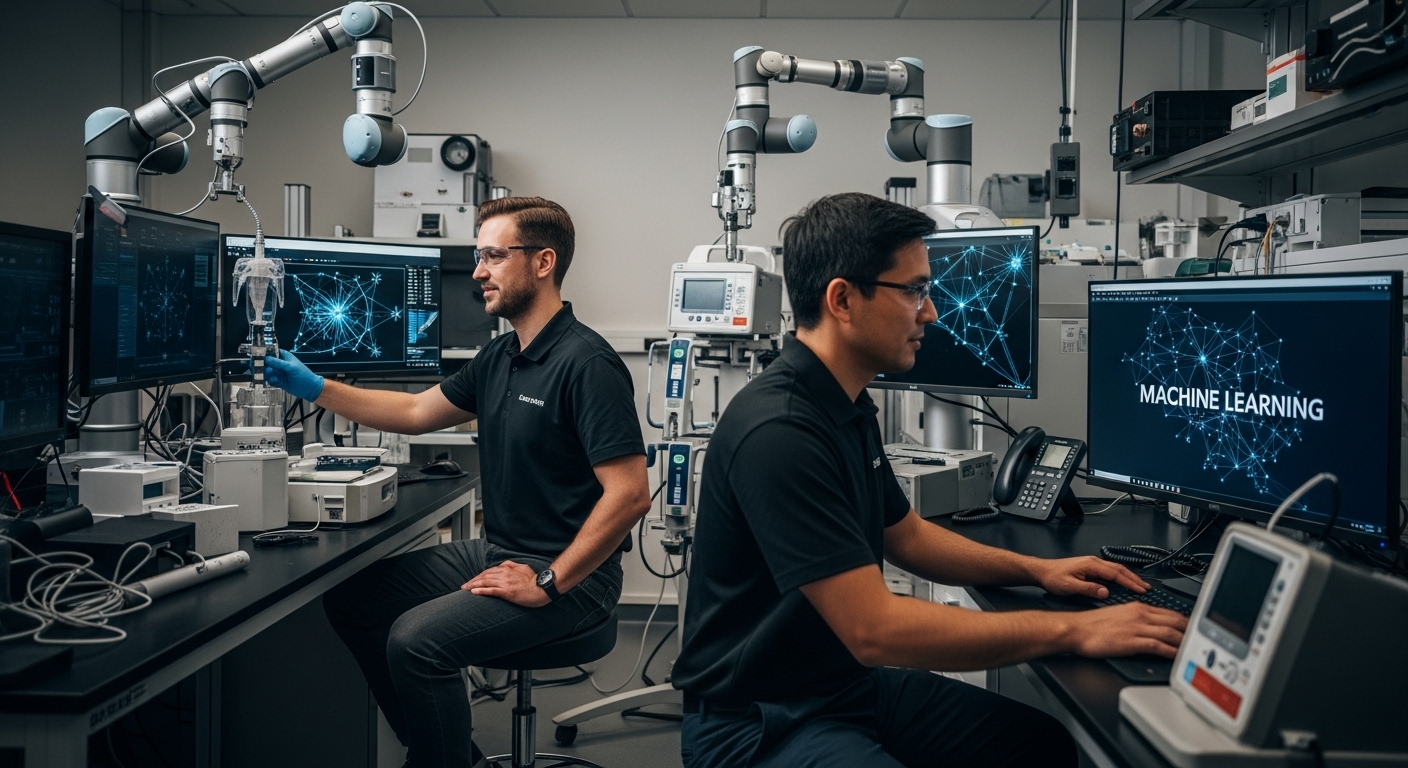Understanding the Role of AI in Innovation

AI is transforming how companies invent, solve problems, and bring new ideas to life. People often imagine automation as AI’s biggest advantage. Yet the truth is, AI lets small startups access tools that once belonged only to giant corporations, opening the innovation game to everyone. This shift is just getting started and the biggest surprises are still ahead.
Table of Contents
- What Is The Role Of AI In Innovation?
- Why Does AI Matter For Business Innovation?
- How AI Drives Innovation In Various Industries
- Key Concepts And Technologies Enabling AI Innovations
- Real-World Examples Of AI Fostering Innovation
Quick Summary
| Takeaway | Explanation |
|---|---|
| AI accelerates R&D processes | AI enables swift prototype creation and predictive modeling, transforming traditional research timelines. |
| AI enhances human creativity | AI augments creative problem-solving by providing new insights and expanding analytical capabilities for innovators. |
| AI democratizes access to technology | Smaller businesses can now leverage powerful AI tools previously limited to larger corporations, fostering innovation inclusivity. |
| AI improves customer personalization | Businesses can utilize AI to analyze customer data and tailor products and services, enhancing overall customer experience. |
| AI drives operational efficiency | By automating processes and optimizing resource use, AI helps organizations achieve significant cost reductions and productivity gains. |
What is the Role of AI in Innovation?
AI has emerged as a transformative force reshaping how businesses conceptualize, develop, and implement innovative solutions. Its role extends far beyond simple automation, acting as a powerful catalyst that amplifies human creativity and problem solving capabilities.
Accelerating Research and Development
AI fundamentally transforms research and development processes by enabling faster, more precise exploration of complex problem spaces. Machine learning algorithms can analyze massive datasets, identify patterns, and generate insights that would take human researchers years to uncover. Research from the U.S. Department of the Interior demonstrates how AI technologies are being strategically deployed to enhance effectiveness across multiple domains.
Key advantages of AI in R&D include:
- Rapid prototype generation
- Predictive modeling of potential outcomes
- Identification of previously unrecognized research pathways
Enhancing Creative Problem Solving
Contrary to traditional perspectives, AI does not replace human creativity but significantly augments it. By processing complex information rapidly, AI provides researchers and innovators with unprecedented analytical capabilities. These systems can suggest novel approaches, highlight potential blind spots, and offer probabilistic scenarios that expand the boundaries of conventional thinking.
AI’s role in innovation involves acting as an intelligent collaborative partner. It synthesizes information from diverse sources, generates hypothetical scenarios, and provides data driven recommendations that human teams can then critically evaluate and refine.
Democratizing Innovation Processes
Perhaps most significantly, AI is democratizing innovation by lowering technological barriers. Small businesses and individual entrepreneurs can now access sophisticated analytical tools that were previously available only to large corporations with substantial research budgets. This shift enables more diverse perspectives to contribute to technological advancement, creating a more inclusive innovation ecosystem.
By breaking down complex challenges into manageable components and providing intelligent insights, AI empowers organizations to experiment, iterate, and develop groundbreaking solutions more efficiently than ever before.
Why Does AI Matter for Business Innovation?
AI has transformed from a speculative technology to a critical strategic tool that enables businesses to reimagine their competitive landscape. Its significance extends beyond technological advancement, representing a fundamental shift in how organizations approach problem solving, strategic planning, and value creation.
Competitive Intelligence and Strategic Insights
Businesses operate in increasingly complex environments where understanding market dynamics quickly can mean the difference between success and obsolescence. AI provides unprecedented capabilities for analyzing vast amounts of data, identifying emerging trends, and generating actionable strategic insights.
Research from Harvard’s Governance in AI Innovation study highlights how intelligent governance supports innovation by building organizational trust and reducing technological risks.
Key strategic advantages of AI include:
- Predictive market trend analysis
- Real time competitive intelligence gathering
- Advanced scenario modeling and strategic planning
Operational Efficiency and Resource Optimization
AI enables businesses to dramatically improve operational performance by automating complex processes and optimizing resource allocation. Machine learning algorithms can identify inefficiencies, predict maintenance requirements, and streamline workflows with a level of precision impossible through traditional methods. This translates into significant cost savings and productivity gains across multiple business functions.
By transforming raw data into intelligent recommendations, AI empowers organizations to make more informed decisions, reduce waste, and allocate resources more strategically.
Personalization and Customer Experience
In an era of increasing customer expectations, AI provides businesses with powerful tools to deliver highly personalized experiences. Advanced algorithms can analyze customer behavior, preferences, and interactions across multiple channels, enabling companies to create tailored products, services, and communication strategies.
This hyper personalization not only enhances customer satisfaction but also creates new avenues for innovation, allowing businesses to develop products and services that precisely match evolving market demands. AI essentially becomes a bridge between complex data analysis and human centered design, driving innovation from both technological and experiential perspectives.
How AI Drives Innovation in Various Industries
Artificial intelligence is revolutionizing industries by introducing unprecedented capabilities that transform traditional operational paradigms. AI’s adaptive and intelligent technologies are not merely incremental improvements but fundamental reimaginings of how different sectors approach challenges, create value, and deliver solutions.
Healthcare and Medical Research
In healthcare, AI is dramatically reshaping diagnostic capabilities, treatment protocols, and medical research. Machine learning algorithms can analyze complex medical imaging with remarkable precision, often detecting subtle anomalies that human experts might overlook. Research from the National Institutes of Health demonstrates how AI enables more personalized and predictive medical interventions.
Key innovations in healthcare AI include:
- Rapid disease pattern recognition
- Personalized treatment recommendation systems
- Predictive health risk assessment
Manufacturing and Industrial Optimization
Manufacturing industries are experiencing a profound transformation through AI driven technologies. Intelligent systems can now predict equipment maintenance needs, optimize production workflows, and create more efficient supply chain management strategies. These technologies enable businesses to reduce downtime, minimize waste, and create more responsive production environments.
AI empowers manufacturers to move beyond reactive maintenance towards truly predictive and proactive operational models, fundamentally changing how industrial processes are conceived and executed.
Financial Services and Economic Modeling
The financial sector has rapidly embraced AI as a critical tool for risk assessment, fraud detection, and investment strategy. Advanced algorithms can analyze massive datasets, identifying complex patterns and potential market movements with a speed and accuracy impossible through traditional analytical methods.
By transforming raw financial data into intelligent insights, AI enables more nuanced economic modeling, personalized financial products, and sophisticated risk management strategies. This technological integration allows financial institutions to make more informed decisions, ultimately creating more adaptive and resilient economic ecosystems.
The following table organizes how AI is driving innovation across key industries, summarizing the main areas of impact and the innovations enabled in each sector for quick comparison.
| Industry | Area of Impact | AI-Driven Innovations |
|---|---|---|
| Healthcare & Medical Research | Diagnostics, Treatment, Research | Disease pattern recognition, personalized treatment, predictive risk assessment |
| Manufacturing & Industrial | Production, Maintenance, Supply Chain | Predictive maintenance, workflow optimization, supply chain management |
| Financial Services & Economics | Risk Management, Investment Strategy, Modeling | Fraud detection, economic modeling, personalized financial products |
| Agriculture & Environment | Crop Management, Sustainability | Precision farming, environmental monitoring, yield optimization |
| Product Design & Engineering | Design Process, Prototyping | Automated design generation, rapid prototyping, performance simulation |

Key Concepts and Technologies Enabling AI Innovations
Artificial intelligence represents a complex ecosystem of interconnected technologies that work together to create intelligent systems capable of learning, adapting, and solving complex problems. Understanding the foundational technologies reveals the sophisticated mechanisms driving AI’s transformative potential.
Machine Learning and Neural Networks
Machine learning serves as the fundamental architecture enabling AI systems to learn from data without explicit programming. Neural networks, inspired by the human brain’s interconnected neuron structure, allow computers to recognize patterns, make predictions, and continuously improve performance. Research from the National Academies of Sciences emphasizes how these technologies create adaptive computational frameworks that can process complex information with remarkable accuracy.
Key components of machine learning include:
- Supervised learning algorithms
- Unsupervised pattern recognition
- Reinforcement learning mechanisms
Data Processing and Computational Infrastructure
The power of AI fundamentally depends on robust data processing capabilities and advanced computational infrastructure. High performance computing systems, cloud technologies, and sophisticated algorithms enable rapid data analysis, complex model training, and real time decision making. These technological foundations allow AI systems to handle massive datasets, execute intricate computational tasks, and generate intelligent insights at unprecedented speeds.
Modern AI infrastructures leverage distributed computing, specialized hardware like graphics processing units (GPUs), and advanced storage technologies to create scalable, efficient computational environments.
Natural Language Processing and Cognitive Systems
Natural language processing represents a critical technological frontier in AI innovation, enabling machines to understand, interpret, and generate human language with increasing sophistication. These systems go beyond simple translation or text processing, developing capabilities to comprehend context, sentiment, and complex linguistic nuances.
Cognitive systems built on these technologies can now engage in increasingly complex interactions, analyze unstructured data, and provide contextually relevant responses across multiple domains. This technological advancement is transforming how humans interact with intelligent systems, creating more intuitive and responsive technological interfaces.
This table summarizes the foundational AI technologies that enable innovation, highlighting each technology and its main characteristics for easier understanding of their roles.
| Technology | Main Characteristics |
|---|---|
| Machine Learning & Neural Networks | Learns from data, recognizes patterns, enables predictions, and improves over time |
| Data Processing & Computational Infrastructure | High-speed data analysis, advanced computing (cloud, GPUs), enables real-time intelligent insights |
| Natural Language Processing & Cognitive Systems | Understands and generates human language, comprehends context, supports intuitive interactions |
Real-World Examples of AI Fostering Innovation
AI has evolved from a theoretical concept to a practical tool driving transformative innovations across multiple sectors. These real-world applications demonstrate how intelligent technologies are solving complex challenges and creating unprecedented opportunities for advancement.
Healthcare and Medical Breakthroughs
In medical research and healthcare, AI is revolutionizing diagnostic processes and treatment strategies. Cutting-edge research from the National Library of Medicine reveals how AI technologies are dramatically improving patient outcomes through advanced diagnostic techniques and personalized medicine approaches.
Specific healthcare AI innovations include:
- Early detection of complex diseases through advanced imaging analysis
- Predictive modeling for personalized treatment protocols
- Automated patient risk assessment systems
Agricultural and Environmental Solutions
Agriculture represents another domain where AI is driving remarkable innovations. Intelligent systems now enable precision farming techniques that optimize crop yields, monitor environmental conditions, and predict potential agricultural challenges. Machine learning algorithms can analyze satellite imagery, soil conditions, and weather patterns to provide farmers with unprecedented insights into crop management.
These AI driven technologies help farmers make data informed decisions, reduce resource waste, and develop more sustainable agricultural practices. By transforming traditional farming approaches, AI creates opportunities for more efficient and environmentally conscious food production.
Manufacturing and Product Design
Manufacturing industries are experiencing radical transformations through AI powered design and production technologies. Intelligent systems can now generate complex product designs, simulate performance under various conditions, and optimize manufacturing processes with remarkable precision.
AI enables engineers and designers to explore innovative solutions by rapidly prototyping, testing, and refining concepts that would previously have taken months or years to develop. This accelerated innovation cycle allows businesses to respond more quickly to market demands, reduce development costs, and create more sophisticated and efficient products.

Turn AI Potential into Real-World Business Innovation with Average Robot
Are you feeling inspired by the possibilities of AI but unsure how to apply those breakthroughs to your own business? This article highlights the power of AI in research, development, and problem solving, yet many small and mid-sized business owners face the challenge of turning these concepts into practical solutions without overwhelming their teams. Issues like automation, resource optimization, and enhancing customer experience are often hard to tackle alone.

With Average Robot, you do not need to navigate AI complexity by yourself. Let your business lead AI transformation using your unique expertise while we provide step-by-step guidance, tailored roadmaps, and hands-on support for every stage. By working together, you can automate repetitive tasks, boost team morale, and unlock bigger market opportunities starting today. Visit our main site to see how our collaborative, jargon-free process can help you turn AI-driven innovation into your biggest competitive strength.
Frequently Asked Questions
What is the role of AI in accelerating research and development?
AI accelerates research and development by enabling faster exploration of complex problems through machine learning algorithms that analyze large datasets, identify patterns, and generate insights more quickly than human researchers.
How does AI enhance creative problem-solving in innovation?
AI enhances creative problem-solving by processing complex information and providing analytical capabilities that suggest novel approaches and highlight potential blind spots, acting as a collaborative partner in the innovation process.
In what ways does AI democratize innovation processes?
AI democratizes innovation by lowering technological barriers, thus allowing small businesses and individual entrepreneurs access to sophisticated analytical tools that were previously available only to larger corporations, fostering a more inclusive innovation ecosystem.
How does AI contribute to operational efficiency in businesses?
AI contributes to operational efficiency by automating complex processes and optimizing resource allocation, enabling businesses to identify inefficiencies, predict maintenance needs, and streamline workflows, resulting in significant cost savings and productivity gains.




